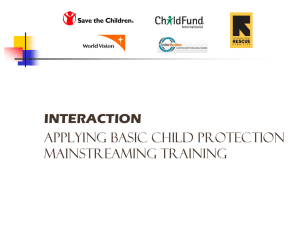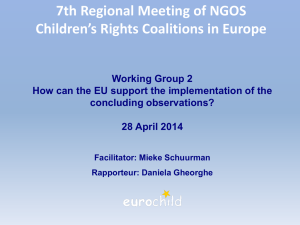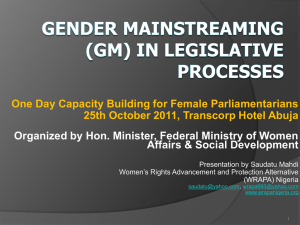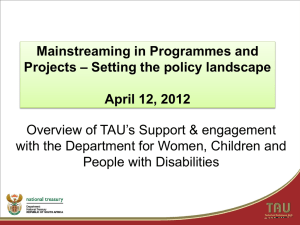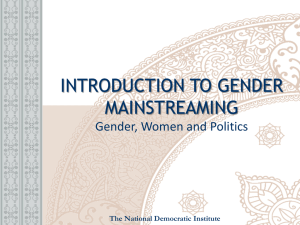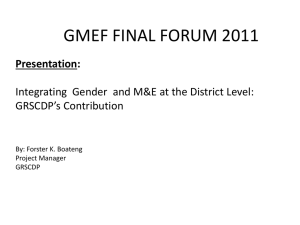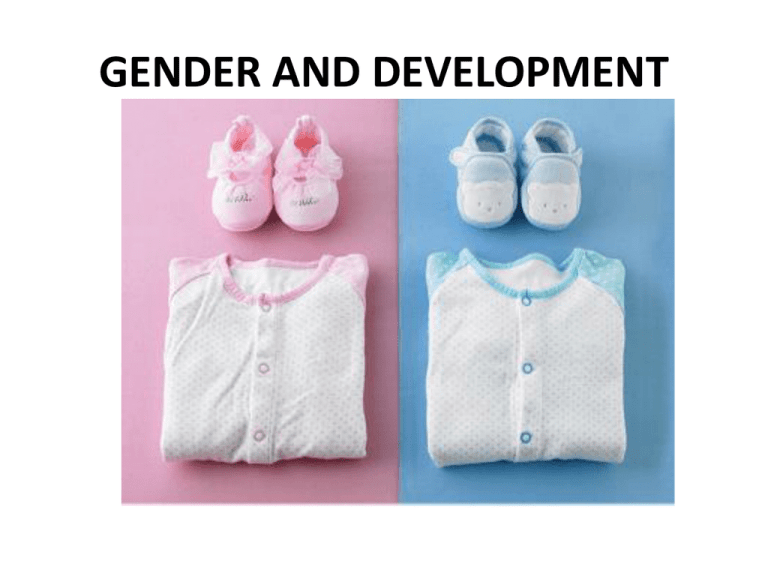
GENDER AND DEVELOPMENT
GENDER AND DEVELOPMENT
1. Historical analysis of cultural construction of
gender, gender agents and gender relations
2. Gender issues in Tanzania
3. Policy analysis and gender mainstreaming
strategies
Introduction
• In the 1950s, Talcott Parsons advanced the
idea that the nuclear family effectively reared
children to meet the labor demands of a
capitalist system.
• According to Parsons:
– Men were more suited for an instrumental
role (the person who provides the family’s
material support and is often an authority
figure).
– Women were more suited for an expressive
role (the person who provides the family’s
emotional support and nurturing).
Introduction
• Conflict theory
– Men have historically had access to most of
society’s material resources and privileges.
– Therefore, it is in their interest to try to
maintain their dominant position
– Man maintain their position through gender
differentiation
• Symbolic Interactionists emphasize how the
concept of gender is socially constructed,
maintained, and reproduced in our everyday
lives.
Gender
• The distinction between sex and gender is
attributed to the anthropologist Margaret Mead
(1935).
• Sex is the biological category, whereas gender is
the culturally shaped expression of sexual
difference: the masculine way in which men
should behave and the feminine way in which
women should behave.
• In this system woman is the Other: the kind of
person whose characteristics are described by
contrast with the male norm.
Gender
• According to Ann Oakley, who introduced the
term to sociology, ‘“Sex” refers to the
biological division into male and female;
• “gender” to the parallel and socially unequal
division into femininity and masculinity’
• Gender draws attention, therefore, to the
socially constructed aspects of differences
between women and men.
Gender
• Gender refers to those behaviours which define
individuals as male or female in particular social
and cultural contexts
• The term gender has since become extended to
refer to more than individual identity and
personality
• Sandra Harding suggests that the study of gender
involves three dimensions, gender symbolism
(culture), the socio-sexual division of labour
(social structure) and gender identities (action
and agency).
Gender
• At the symbolic level gender refers to, to
cultural ideals and stereotypes of masculinity
and femininity
• culturally dominant ideas about masculinity
and femininity are stereotypes which
correspond only crudely to reality.
• At the structural level, gender refers to the
sexual division of labour in institutions and
organizations.
Gender
• At the structural level, there is the unequal
division of labour in the household, even
between women and men who both have fulltime jobs outside,
• Discrimination in employment, where sex
(rather than individual skills and
qualifications) plays a large part in
determining types of job and chances of
promotion.
Gender
• There are huge cross-cultural variations in
ideas about gender and in the roles of men
and women.
• Baby boys and girls are turned into adult men
and women by the processes of socialization
in child-rearing, education, youth culture,
employment practices, and family ideology.
Criticism of the concept of gender.
• There have been two major kinds of criticism
of the concept of gender.
• Firstly it is based upon a false dichotomy
between the biological and the social.
• This relates to a general criticism that
sociology has tended to see the social as
disembodied, with the infant as a tabula rasa
upon which socialization may write at will, to
produce social consciousness and action.
Criticism of the concept of gender.
• The sex/gender distinction, it is said, is linked
to a particular form of feminist politics that
seeks the eradication of gender and a move
towards androgyny;
• It leaves little space, for instance, for other
feminist concerns with the biological politics
of menstruation, contraception, reproductive
technology, abortion, or the management of
childbirth.
Criticism of the concept of gender.
• The second kind of criticism relates to the way
in which the concept of gender focuses on
differences between women and men at the
expense of power and domination.
• Some writers would prefer to use the term
patriarchy as the main organizing concept, in
order to keep the question of power to the
fore, both analytically and politically.
Criticism of the concept of gender.
• Patriarchy means ‘Rule by the father
• A doctrine especially associated with Filmer: political
authority was divine authority, descended from
Adam through the kings of Israel to modern kings. It
justified the divine right of kings.
• The word is used by feminists to decry the practice,
whether principled or unthinking, of giving primacy
to the male over the female.
• Patriarchal practices of all sorts are widespread even
in societies which claim to practice equal
opportunities.
Criticism of the concept of gender.
• On a lighter note, ‘gender’ has been criticized
as a prudish way of avoiding the word ‘sex’.
• It is true that gender has entered everyday
speech in this sense, when people talk (for
example) about ‘the opposite gender’. Some
sociologists, too, are guilty of this when they
refer to ‘gender roles’ or ‘gender
discrimination’.
Biological Factors in Gender Differences:
HORMONES AND SOCIAL BEHAVIOR
•
Sex- usually thought of as a biological term
referring to ascribed genetic, anatomical,
and hormonal differences between males
and females, but it is actually determined by
socially accepted biological criteria, e.g.:
– Intersexed- persons with ambiguous
genitalia (usually ascribed one or another
sex in different cultures)
Biological Factors in Gender Differences:
HORMONES AND SOCIAL BEHAVIOR
• About 1 babies in 1,000 are born intersexed, or
hermaphroditic, which means having an
abnormal chromosomal makeup and mixed or
indeterminate male and female sex
characteristics.
• This is a function of biological sex.
• Gender is different because it relates to the way
that a person behaves based on their biological
sex.
• In other words, we learn how to act manly or
womanly based on the sex that we’re born into
and society’s expectations of that sex.
Biological Factors in Gender Differences:
HORMONES AND SOCIAL BEHAVIOR
• Human Studies: Girls who have received
testosterone or testosterone-like hormones
prenatally have masculinized behavior.
– These girls are genetic females but their
genetalia are typically masculinized at birth
(enlarged clitoris, fused labia that resemble
a scrotum).
– They often receive an operation to make
her appear more feminine.
Biological Factors in Gender Differences:
HORMONES AND SOCIAL BEHAVIOR
– These girls have masculinized behavior:
Tomboyish, liked vigorous athletic activities,
simply utilitarian clothing; little interest in
dolls, babysitting, or caring for younger
children, jewelry, cosmetics, or hair styles.
– They also had a more male-type
achievement pattern and male-type
attitudes toward sexuality. They preferred
boys as playmates and boys' toys.
Biological Factors in Gender Differences:
HORMONES AND SOCIAL BEHAVIOR
• HORMONES AND COGNITIVE SKILLS
– There is evidence for a critical period for brain
organization and hemisphere lateralization (males
more lateralized).
– Testosterone surge prenatally is responsible. This
surge makes females process verbal information
better and males process spatial information
better.
– Female fetuses exposed to abnormally high levels
of androgens are better at spatial abilities.
GENDER AGENTS
• One of the understandings that underlies most
theoretical approaches to gender differences
involves differences in gender socialization.
• Socialization is the process that conveys norms
and behaviors to potential members of a group.
• Gender socialization is the process of educating
and instructing potential males and females as to
the norms, behaviors, values, etc. of group
membership
GENDER AGENTS
• Gender socialization is influenced by different
institution which are commonly called gender
agent.
• Gender agent include : families, schools, peer
groups, mass media, religious institutions,
work place etc.
• These agent provide both formal and informal
“training”
GENDER AGENTS
• Gender role
socialization is the
lifelong process of
learning to be masculine
or feminine, primarily
through four main
agents of socialization:
families, schools, peers,
and the media.
23
FAMILIES
• Families are usually the primary source of
socialization and greatly impact gender role
socialization.
• Social learning theory suggests that the
babies and children learn behaviors and
meanings through social interaction and
internalize the expectations of those around
them.
– remember: we learn gender, we are not born
knowing who wears pink
FAMILIES
• Consequences of Gender Expectations
Women are denied access to power, influence,
achievement, and independence in the public
world.
Men are denied access to nurturing,
emotional, and other-oriented worlds that
women traditionally inhabit.
FAMILIES
• Through close interaction with parents and small
number of others, child:
Learns to think and speak
Internalizes norms, beliefs, and values
Learns gender roles
Develops capacity for intimate and personal
relationships
• Cross-culturally, it is okay for girls to choose boy
toys, but not vice versa.
FAMILIES
Using their toy wheel
barrows to help their father
with the gardening, these
boys are, according to Mead,
“taking on the role of the
other” and achieving an
understanding of themselves
as separate social agents.
FAMILIES
• from birth, boys & girls are handled differently
boys: jostled with, played with more roughly,
handled more as an infant, punished more, have
more freedom, not encouraged to be effeminate
• girls: cuddled, talked to more, punished with
more gentle reprimands, encouraged to be neat,
obedient, feminine, quieter, passive, controlled
FAMILIES
• Socialization affected by:
Social class of parents
Parenting style
Preparedness of parents for parenting role
Psychological health of parents (e.g., neglect,
abuse, or abandonment of child)
Family type (e.g., single parent family, blended
family)*
SCHOOLS
• Schools also socialize children into their
gender roles.
• For instance, research shows that teachers
treat boys and girls differently.
• This may teach children that there are
different expectations of them, based on their
sex.
SCHOOLS
• Teach children indirectly to be less
emotionally dependent
• Adjust children to their social order
• Build character through formal curriculum and
“hidden curriculum”: Informal teaching that
helps ensure students’ integration into society
• Reinforce gender roles*
PEER GROUPS
• Peer group: Individuals usually of same age
who enjoy approximately equal status
• In childhood, formed largely by accident of
association
Later in life, tend to choose peer groups based
on certain criteria
• Only agent of socialization in childhood and
youth not controlled mainly by adults…*
PEER GROUPS
• Allow children and young people:
Opportunities to engage in experiences not
provided in family, including examining
feelings, beliefs and ideas not acceptable to
family
Opportunities for self-direction and selfexpression
• Can strongly shape individual’s aspirations and
behaviours through stringent demands for
conformity*
THE MASS MEDIA
• Create, manage, and control impressions of what
is deemed important and real
• May inadvertently perpetuate stereotypes
• May teach individuals to become obedient
consumers
• Exert powerful socializing influence but effects
difficult to measure
Most effects impersonal and transmitted in one
direction
RELIGION-Christianity
• The LORD God said, "It is not good for the man to
be alone. I will make a helper suitable for him."
(NIV, Genesis 2:18)
• To the woman he said, "I will greatly increase
your pains in childbearing; with pain you will give
birth to children. Your desire will be for your
husband, and he will rule over you
• Jesus appointed only men as His twelve apostles,
and this is taken as a sign of women's secondary
status.
RELIGION-Christianity
• Grounded in scriptures from the
Old and New Testaments that
delineate gender roles, duties,
and relations.
• Men are the heads of households
and religious and political leaders.
• Women are to be in subjection to
their husbands and other male
members of their families and
religious community.
• Some Christian fundamentalists
practice polygamy.
RELIGION-Islam
• 4:34 "Men are in charge of women, because
Allah hath made the one of them to excel the
other, and because they spend of their
property (for the support of women). So good
women are the obedient, guarding in secret
that which Allah hath guarded. As for those
from whom ye fear rebellion, admonish them
and banish them to beds apart, and scourge
them."
RELIGION-Islam
• Islam affirms “natural differences” between
men and women. Hence, the rights and
obligations of men and women, and their
roles in the Muslim community, are not
identical.
• These differences are motivated by the Islamic
conception of the role of women in the family
and the Muslim community.
RELIGION-Islam
Grounded in passages from
the Koran that delineate
gender roles, duties, and
relations.
Men are the heads of
households and religious and
community leaders.
Women are to be in subjection
to their husbands and other
male members of their
families and religious
community.
Practice polygamy.
People often exhibit multiple social identities simultaneously
sometimes seemingly conflicting ones.
Essentials Of Sociology, 3rd Edition
Copyright © 2011 W.W. Norton & Company
RELIGION-Islam
• Differences in gender roles do not imply the
superiority of one gender over the other.
• Equality of men and women are part of the
ethics, spirituality, and humanity of Islam.
• The Qur'an makes it clear that the sole basis
for superiority of any person over another is
piety and righteousness, not gender, colour or
nationality
RELIGION-Islam
• O mankind! We created you from a single
(pair) of a male and a female and made you
into nations and tribes that you may know
each other, Verily the most honoured of you in
the sight of Allah is (one who is) the most
righteous of you. And Allah has full knowledge
and is well acquainted (with all things).
(Qur'an 49:13)
Gender relations
• Gender relations are the ways in which a
culture or society defines rights,
responsibilities, and the identities of men and
women in relation to one another (BravoBaumann, 2000).
• It is a sort of pre determined position it relates
responsibility in the family/ society according
to deferent cultures depending on the
domination of the male or female
Gender relations
• Gender relations are power relations between
men and women.
• The ideology that gender differences between
men and women are shaped by the exercise of
power by men over women underpins this
definition.
• Changing these power relations
women’s
empowerment
and
conscientisation.
entails
men’s
Gender relations
• The nature of power relation varies from
space and time, but may be:
• Related to production (Economic power)
• Reproduction (health and children)
• Social power(education, religion, recreational)
• Political power ( political representation and
decision making)
Gender issues in Tanzania
Tanzania’s National Strategy for Gender & Development
identified key challenges relating to gender equality :
1. Patriarchal system; customs & traditions that
discriminate against women and perpetuate
gender inequalities
2. Inadequacies of the legal and institutional
framework
3. Lack of capacity for implementing programs
towards gender equality & women’s
empowerment
Gender issues in Tanzania
4. Persistent and increasing burden of
poverty on women
5. Inequalities in arrangements for productive
activities and in access to resources
6. Inequalities in the sharing of power and
decision‐making
Gender issues in Tanzania
6.
Inequalities in the sharing of power and
decision‐making
Tanzania ranks 15 out of 187 countries in terms of
women seated in the of national parliaments.
Most of this is due to the provision of “special seat”
quotas, established when the country moved from a
single-party to multi-party system in 1992.
7. Inequality in access to education,
especially secondary and tertiary education
Gender issues in Tanzania
8. Lack of respect for and inadequate promotion and
protection of the human rights of women, this
involve:
Domestic and intimate partner violence
Sexual violence
GBV
Female genital mutilation
Trafficking
GBV is any harm that is done against a person’s will
based on their gender and that has a negative impact on
that person’s physical and psychological health,
development, and identity
Gender issues in Tanzania
• Narrated 'Abdullah bin Zam'a:
• The Prophet forbade laughing at a person who
passes wind, and said, "How does anyone of
you beat his wife as he beats the stallion camel
and then he may embrace (sleep with) her?"
And Hisham said, "As he beats his slave
• Bukhari :: Book 8 :: Volume 73 :: Hadith 68
Gender issues in Tanzania
• It is narrated on the authority of Abu Musa
Ash'ari: I asked the Messenger of Allah which
(attribute) of Islam is more excellent. Upon this
he remarked: One in which the Muslims are
safe, protected from the tongue and hand of
(other Muslims). ……
• The Book of Faith (Kitab Al-Iman)
• Muslim :: Book 1 : Hadith 66
Gender issues in Tanzania
• Narrated Abu Huraira: Allah 's Apostle said,
"Treat women nicely, for a women is created
from a rib, and the most curved portion of the
rib is its upper portion, so, if you should try to
straighten it, it will break, but if you leave it as
it is, it will remain crooked. So treat women
nicely."
• Bukhari :: Book 4 :: Volume 55 :: Hadith 548
Gender issues in Tanzania
9. Inequalities in managing natural resources and
safeguarding the environment
The key environmental challenges Tanzania currently
faces include:
– Access to potable water
– Soil degradation
– Deforestation
– Desertification
“ many women and girls walk long distances to bring water to
their families, often at the expense of education, income generating
activities, cultural and political involvement, and rest and recreation.”
Policy analysis and gender
mainstreaming strategies
Policy analysis: a systematic, organized way to
evaluate public policy alternatives or the
programs themselves
– used in a variety of ways
• assessing problems
• developing alternatives
• evaluating implemented programs
– can be used to influence policy
Lowi Policy Typology
• Distributive policy
– individualized grants and programs
• Redistributive policy
– one gains from another’s loss
• Regulatory policy
– government restriction of choice
Policy have impact on gender and affect men and
women differently. It is important to examine
gender gap in policy
55
A Framework for Diagnosis and Policy
Intervention
1. What are the
gender gaps in
this country?
• Economic Participation
and Opportunity
• Educational
Attainment
• Health and well-being
• Political
empowerment
2. What are the
causes of those
gen der gaps?
Proximate Causes
• Tertiary enrollment
Root Causes
• Prejudice
• Preferences
• Constraints
56
3. What policy
change can close
the gender gaps?
Policy Levers
• University
scholarships for
women
Capabilities necessary
for policy change
• Education budget
GENDER MAINSTREAMING
• Historically in 1960s of a universal women's
movement, raising awareness on women’s role
and issues in the development and humanitarian
field, has invited governments and international
development agencies to respond
• In the 1970s, focus was placed on the Women in
Development movement (WID), which influenced
the way the development community integrated
women; main objectives were social and political
equality for women
GENDER MAINSTREAMING
• Women in Development’ (WID)
– Rooted in modernisation theory and liberal
feminist ideas on equality
– Economic change = empowerment
– Rise of micro-credit policies and the
recognition of women in productive
economy
GENDER MAINSTREAMING
• In 1979, a major step was achieved through
the adoption of the Convention on the
Elimination of all Forms of Discrimination
against Women. (CEDAW)
• The WID approach faced various problems,
particularly as programmes and policies
adopted did not always succeed in improving
women’s situations, mainly in developing
countries where the greatest needs were
identified.
GENDER MAINSTREAMING
• In response to this problem, the Women and
Development Theory (WAD) arose in the late
1970s, aimed at highlighting the relationship
between women and the development
process.
• WAD never managed to go beyond academic
discussion to field programming and led the
way to the Gender and Development Theory
(GAD) in the 1990s which promoted gender
mainstreaming
GENDER MAINSTREAMING
• Women and Development’ (WAD)
– Rooted in dependency theory and Marxist
feminist ideas
– Economic change = empowerment
– Advocated no real policy change around
involving women in the development
process
GENDER MAINSTREAMING
• Gender and Development (GAD) Ideas and
Concepts:
• Equality vs. inequality
• Roles, identity and value
• Empowerment and power
• Beyond household analysis
• Practical vs. strategic interests
• Double burden
• Men and masculinities
• Gender mainstreaming
GENDER MAINSTREAMING
• The Fourth World Conference of Women,
organized in Beijing in 1995, confirmed the
need for an enhanced framework for
international cooperation on gender issues
• The international community made strong
commitments to gender mainstreaming and
gender balance, including the empowerment
of women.
GENDER MAINSTREAMING
• The UN Economic and Social Council, ECOSOC
examined gender mainstreaming more
specifically in 1997 and issued a series of
recommendations for mainstreaming the
gender perspective in the UN System.
• At the Beijing+5 review in 2000, Member
States and the international community
confirmed their commitment to accelerate
gender balance implementation.
GENDER MAINSTREAMING
• The ECOSOC defined gender mainstreaming is a
• "strategy for making women’s as well as men’s
concerns and experiences an integral dimension
for the design, implementation, monitoring and
evaluation of the policies and programmes in all
political, economic and societal spheres so that
women and men benefit equally and inequality is
not perpetuated".
GENDER MAINSTREAMING
• Gender mainstreaming is a strategy/means for
achieving gender equality.
• The approach seeks to reorganize and restructure
policies, institutions, and social programs by
taking women’s and men’s perspectives,
experiences, and needs into consideration.
• Gender mainstreaming does not replace, but
supplements, specific targeted interventions to
address gender inequality such as affirmative
action.
Why do we need Gender Mainstreaming?
Gender
differentiated
division of labour
Society and
family’s gender
differentiated
expectations and
Gender
Inequity
Gender
differentiated
needs,
interests, etc.
Gender mainstreaming strategies
• Gender mainstreaming in policy analysis and
development draws attention to the impact of
policy on people and explores how this impact
could vary for women and men, given gender
differences and inequalities.
• A gender perspective contributes to a more
informed view of policy options and impacts.
• It enable decision-makers to assess the
potential to narrow gender gaps.
Gender mainstreaming strategies
• The mainstreaming strategy seeks to ensure that
gender considerations are routinely included in
the assessment of policy issues, options and
impacts, along with other considerations such as
socio-economic dimensions.
• It also routinely seeks increased gender equality
as one of the policy outcomes, along with
growth, efficiency, poverty reduction, and
sustainability.
• This requires the inclusion of gender perspectives
at several points in the policy process.
Steps in Gender mainstreaming strategies
• 1. Taking Gender perspectives in the
formulation of the policy issue/question to be
addressed.
• 2. To ensure Gender perspectives are relevant
to the definition of the information needs to
assess policy options. Information on both
women’s and men’s situations should be
incorporated in the decision-making process
Steps in Gender mainstreaming strategies
• 3. To assess the implications of different options
by gender. Various options could have different
costs and benefits for women and men and
different consequences for gender relations and
gender equality
• 4. To take into account in the determination of
who will be consulted and how on matters such
as the formulation of the issue, the definition of
information needs, and assessment of options.
Steps in Gender mainstreaming strategies
• 5. To reflect the information and analyses on
gender equality issues resulting from the
previous step in the formulation of
recommendations for policy choices.
• The government of Tanzania has
undertaken various efforts in
mainstreaming gender in development
policies, programmes and strategies
Tanzania Experience
• Government strategies in program and policy
usually include:
• Working with international organization on
the issue
• Creating legal frame work including, enacting
laws, reviewing the constitution, formulating
policy and strategy
• Building institution to deal with the problem
• Financial and political commitment.
Tanzania Experience
• Tanzania has signed various international
human rights instruments which bind it morally,
and legally to adhere to equity policies
and non discriminatory policies in the
development process.
1979- CEDAW
1989- Convention on the Rights of Child (CRC);
1995- Beijing Platform of Action
1998-SADC Declaration on Gender and
Development,
2003- African Charter of Human and Peoples
Rights etc
Tanzania Experience
• GOT has ratified ILO Declaration on
the Fundamental Principles and Human
Rights at work. These instruments bind the
government morally and legally to pursue nondiscriminatory policies and development
programmes and processes.
• GOT vision (2025), which has been
operationalised through PRSP I and II
(MKUKUTA), has addressed gender in the key
outcomes areas and targets.
Tanzania Experience
• In 1990 The Ministry of Community
Development, Gender and Children was
established as the national machinery for
spearheading gender development in the
country.
• In 2000 and 2004 the Government amended
the 1977 Constitution among other things, to
increase women’s participation in the National
Parliament and Local Authorities.
Tanzania Experience
• The Government also formulated the Women and
Gender Development Policy (2000) to put more
emphasis on the Women in Development Policy
(WID) (1992) in line with the Beijing Platform for
Action.
• GOT formulated a National Strategy for Gender
Development (NSGD) to ensure effective
implementation of the Women and Gender
Development Policy, and to promote gender
equality and equity
Tanzania Experience
• Legal frame work: GOT has established the Human
Rights and Good Governance Commission, amended
the Public Leadership Code of Ethics
• GOT has passed laws to protect women, girls and
children. These are:
The Sexual Offences (Special Provisions) Act No. 8 of
1998,
the Land Act No. 4 of 1999 and Village Land Act No. 5
of 1999. Other laws are being reviewed.
These include the Marriage Act No. 5 of 1971,
Succession and Inheritance Laws and laws relating to
children.
Tanzania Experience
• Government reform Programmes taken gender as
one of the components. For instance, the civil
service reforms education etc. Other specific
gender programmes in the education, health,
water, agricultural sectors and TACAIDS.
• GOT has adopted the Gender Budgeting
Initiative (GBI) and including gender in budget
guidelines, It is also involving CSOs in the
engendering of budget
• There is collaborative efforts between CSOs
actors and individual Government sectors e.g.
Campaign promoting women and girls right
Glossary
• Gender is the social attributes and opportunities
associated with being male and female and the
relationships between women and men and girls
and boys, as well as the relations between
women and those between men.
• Gender division of labour refers to the
classification and allocation of tasks for women
and men in managing domestic and community
activities. Gender division of labour inflicts
gender stereotyping.
Glossary
• Gender stereotyping is a way of thinking that
persists in people’s attitudes and practices and
is also often reflected in policies and laws of a
country or community.
• Gender Equity is synonymous with fair
opportunity in access to social services.
Gender equity therefore means fair
opportunity and access to social services for
both women and men.
Glossary
• Gender blind : This is a conscious or
unconscious way of doing or saying things
without recognizing or considering differences
in position, needs and feelings based on
gender
• Gender bias: occurs when there are gender
disparities and differential treatments given to
people on the basis of sex such as resources
and opportunities for better life.
Glossary
• Gender discrimination: occurs when one sex
is treated either better or worse than the
other on the basis of sex.
• Gender oppression is a result of imbalance of
power between women and men. Gender
oppression occurs when one sex is treated in
cruel, harsh manner or made to feel
uncomfortable or unhappy in socio-economic
and political life.
Glossary
• Gender equality refers to equal and fair
treatment of women and men members of a
community in provision and access to goods
and services required to meet their social
needs. It includes fair treatment before the
law, the undeniable right to life by each
member of the community.
Glossary
• Gender violence refers to any act, omission or
conduct by means of which physical, sexual or
mental suffering is inflicted directly or
indirectly, through threat, coercion, or any
other means on any person with the purpose
of intimidating, punishing, humiliating,
maintaining sex stereotyped roles,
undermining the security of a person, self
respect or diminishing physical or mental
capacities
Question
1. Critically discuss the main efforts taken by
the government of Tanzania in
mainstreaming gender.
2. Discuss how cultural practice and belief
perpetuate gender discrimination in Tanzania
3. What is the rational for including gender
mainstreaming in government development
programme
Question
4. There is a school of thought that argue that
“Gender mainstreaming has failed, it should be
abandoned and the focus should be on women’s
rights and empowerment.” How far is this
statement true
5. With vivid example illustrate how gender is
socially constructed out of biological Sex
differences. What are some of the criticism of
this argument?
6. Discuss the theory and practice of WID, WAD,
and GAD

